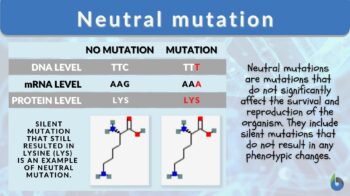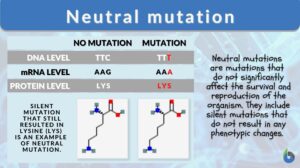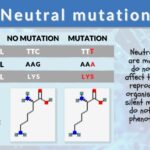
Neutral mutation
n., plural: neutral mutations
[ˈnjuːtɹəl mjuˈteɪʃən]
Definition: mutation that does not harm or benefit the survival and reproduction of an organism
Table of Contents
Neutral Mutation Definition
What is a neutral mutation? Neutral mutations are the alterations in the DNA that are non-detrimental and non-beneficial for the survival and reproduction of the organism. Neutral mutations do not result in any phenotypic changes also. As these mutations do not change the resultant amino acids or proteins, these mutations are referred to as neutral mutations.
To define as per population genetics, neutral mutations are the mutations whose spread remains unaffected by the process of natural selection. In other words, fixation of the neutral mutations is independent of natural selection. Since these mutations can escape the process of natural selection, these mutations accumulate and add to the variations in the genetic pool or the genetic drift. Genealogies or phylogenies are built or marked based on these neutral mutations.
Lifetime reproductive success, fecundity, longevity, viability, etc., are some of the life-history traits that determine the fitness of the genotype. Genetic alteration in these traits critically determines the adaptability of an organism to its new environment. Accordingly, mutation can be deemed beneficial or harmful, and this also forms the basis of survival of the fittest.
Beneficial mutations are transferred to the next progeny as they become essential for survival. However, besides these harmful and beneficial mutations, there are a number of mutations that contribute to the variations in the genetic makeup of the individuals. However, they have no phenotypic expression of these changes and do not alter the ability to survive and reproduce. Thus these mutations have been termed neutral mutations. Interestingly, most mutations are neutral mutations. Neutral mutations also form the basis of the neutral theory of molecular evolution and the molecular clock.
A neutral mutation is a type of mutation wherein the alteration in the DNA is not detrimental and also not beneficial for the survival and reproduction of the organism. It is the most frequent type of genetic mutation. Examples of neutral mutations are silent mutations.
History
Darwin proposed the theory of evolution wherein only the fittest survives the process of natural selection. Accordingly, the mutations that have a beneficial effect only survive the process of natural selection. However, Darwin mentioned that neutral mutations result in genetic variation and neutral traits, which eventually get fixed in a species.
A century later, population geneticist Motoo Kimura proposed evolution’s ‘neutral theory‘. This theory gave equal fitness to all the genotypes and had an equal likelihood to pass onto the next generation irrespective of its allele type. As per the neutral theory, molecular diversity in a species is attributed to neutral mutations. The neutral mutation hypothesis for evolution helps to understand the fundamental evolutionary question of how genetic variations are created in the life-history traits and are preserved in a population, even though natural selection is underway.
Impact on Evolutionary Theory
Two processes determine the evolution of living organisms:
- Mutation-induced genetic variability that is continuously generated within populations
- Variations in the frequency of alleles within populations over time
The process of natural selection that selects the fittest also plays a significant role in the fate of the mutations. Mutations that confer higher fitness are naturally selected, and their frequency increases until they are fixed by replacing the ancestral population alleles. This process of evolution is referred to as positive or directional selection. On the contrary, harmful mutations, i.e., mutations that reduce the carrier’s fitness, gradually disappear from the population by a process known as negative or purifying selection.
Interestingly, certain mutations are beneficial only when present in heterozygous and not in homozygous; such mutations occur in a population in intermediate frequency by a process known as balancing selection.
Now consider a situation wherein the fitness of all genotypes is the same or neutral mutation, and all have an equal probability of passing through the natural selection. In such a situation process of natural selection is not applicable. In a population, each individual produces multiple gametes; however, only a few succeed in developing into adults. Thus, through each generation, the frequency of an allele is an outcome of a random process of gamete sampling by a process known as genetic drift. Genetic drift fixes certain alleles while eliminating others. Thus, genetic drift is involved in determining genotypic variation in a population. Here it is also important to note that genetic drift differs from natural selection. Natural selection is unidirectional, while genetic drift is a random process.
Thus, mutations that do not affect an individual’s fitness, i.e., neutral mutations, are driven by genetic drift and remain unaffected by natural selection. The neutral gene hypothesis is based upon the fact that alleles have equal fitness, and thus the process of natural selection does not apply to them.
Genetic drift and negative selection thus form the central dogma of the Neutral theory evolution. In contrast, positive selection forms the primary locus of Darwin’s theory of evolution. However, an important point to understand is that genetic drift is not limited to neutral mutations only; in some instances, beneficial mutations may be lost due to genetic drift, while harmful mutations may get fixed.
Types
The different types of neutral mutations are as follows:
1. Synonymous mutation of bases
This is also known as the silent substitution of the base. These are the substitutions that do not change the amino acids, i.e., the substitutions that change the DNA sequence; however, there is no change in the encoded amino acid. These substitutions usually occur at the third position of the code. Because of the redundant nature of the genetic code, the encoded amino acid remains unchanged even after the change in the base sequence. For example, glycine (Gly) can be coded by GGG, GGA, GGC, and GGT (GGU, in mRNA); hence any change in the third position of the base A to G (or vice versa) will not affect the resultant amino acid. See Figure 1.

2. Neutral amino acid substitution
In these substitutions, amino acid changes as a result of the point mutation in the DNA. However, the new amino acid formed after substitutions does not alter the functionality of the protein. Such substitutions are known as neutral amino acid substitution.
Identification and Measurement of Neutrality
Neutral mutations are a measure of genetic polymorphism in population genetics and evolutionary genetics. The allozyme frequency is measured with the help of standard gel electrophoresis. The data collected is then evaluated based upon the population size, mutation rate, and population size.
The presence of higher heterozygosity than predicted and variation in protein isoforms then helps to determine and predict the cause of the variation as natural selection or genetic drift.
The neutral theory of evolution is based on the assumption that the fixation frequency of neutral mutations is directly correlated to the frequency of generation of neutral alleles, i.e., the rate of fixing of a neutral mutation (substitution rate) is proportional to the mutation rate by new substitution.
As per the original Kimura’s calculations, neutral mutations have |2 Ns|<1 or |s|≤1/(2N)
where,
- N– Effective population size [assuming equal sex ratio and no immigration, migration, mutation or selection]. In general, the effective population is assumed to be 1/5th of actual population size.
- s– selection coefficient whose value ranges from 0 (means genotype not selected for next generation] to 1 [means genotype is completely selected for next generation]
Let us consider a case wherein a DNA with equivalently selective alleles are present, and the rate of mutation per generation is represented as-u. So, in a haploid population with size N, the number of mutations at this site in each generation would be Nu. So, now in a haploid population, the relative frequency reaching fixation would be 1/N.
Hence, the rate of substitution per generation, K, for neutral mutations can be obtained as :
K = Nu × 1/N = u
However, under natural selection, beneficial mutations would have a higher probability of fixation and hence, K > u, whereas, in the case of harmful mutations, the negative selection will come into play and K < u. This also forms the basis for evaluating the selection. Further, for estimating selection over a long duration of time, the McDonald-Kreitman test is used.
Molecular clocks
Molecular clocks help to determine the divergence time of two species based upon the mutation rates of the biological molecules, namely DNA, RNA, amino acids, and proteins. The molecular clock concept was introduced by Emile Zuckerkandl and Linus Pauling in the early 1960s.
The molecular clocks are based on the hypothesis that the evolution of DNA and protein sequence among different organisms is relatively constant or fixed over a period of time. This theory of molecular clock is also known as the rate-constancy hypothesis. This hypothesis directly implies that the difference in the genetic constitution of two organisms is directly proportional to the duration elapsed since these two organisms share a common ancestor. Thus, molecular clocks become an essential tool for estimating the evolutionary biology and the timescale involved in it.
Cytochrome C was the first protein that was used to estimate divergence time in 1972. A phylogenetic tree was created based upon the molecular data of cytochrome C. Cytochrome C is an essential cellular respiration enzyme present in all species. The number of nucleotide base substitutions in the cytochrome C gene in 29 eukaryotic species was carried out to generate the phylogenetic tree. This phylogenetic tree was then compared with the paleontological data for similarity. Interestingly, the phylogenetic tree matched the paleontological data.
Try to answer the quiz below to check what you have learned so far about neutral mutation.
References
- Kumar, S., & Patel, R. (2018). Neutral Theory, Disease Mutations, and Personal Exomes. Molecular biology and evolution, 35(6), 1297–1303. https://doi.org/10.1093/molbev/msy085.
- Ochman H. (2003). Neutral mutations and neutral substitutions in bacterial genomes. Molecular biology and evolution, 20(12), 2091–2096. https://doi.org/10.1093/molbev/msg229.
- Kern, A. D., & Hahn, M. W. (2018). The Neutral Theory in Light of Natural Selection. Molecular biology and evolution, 35(6), 1366–1371. https://doi.org/10.1093/molbev/msy092
- Saitou N. (2018). Neutral Evolution. Introduction to Evolutionary Genomics, 17, 109–148. https://doi.org/10.1007/978-3-319-92642-1_5
©BiologyOnline.com. Content provided and moderated by Biology Online Editors.








